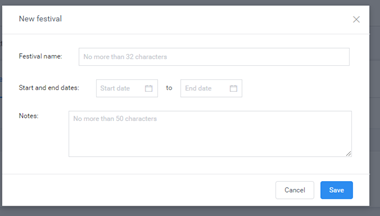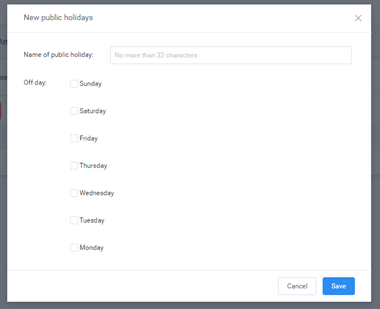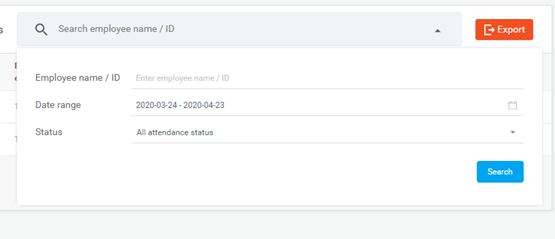Using attendance management
7.0 Attendance rules
[Attendance rules] Add, modify and delete related rules including shifts, holidays, public holidays, and device groups, etc. are set in this module.
7.1.1 Shift settings
The shift setting contains a default shift. Click the new shift button to increase the shift. Click the modify shift icon in the operation to modify the parameters in the current shift. Click the delete shift icon in the operation to delete the current shift.
· New shift
Click the New shift button to open the new shift settings interface
· Shift name
1)The name can be customized to enter no more than 32 characters.
· Shift settings
1)The default is one shift. You can click the Add button to add shifts and set up to 4 shifts. 2)ou can select / clear / customize the specific working / off time within the time period. 3)You can select and customize the minutes limit for late arrival and early departure in the notes. 4)Click the delete icon in the operation to delete this shift.
· Overtime rules
1) You can manually enter and select the length of time required to work overtime on workdays and the time off work.
2) You can manually enter the length of time required for overtime on public holidays and holidays, as well as working time and off time.
7.1.2 Holiday settings
Click New holiday to customize the time period of various holidays. Click the Modify to modify the parameters of the currently set holiday. Click the delete to delete the current holiday.
· New holiday
Click New holiday to open the new holiday

·
Holiday name
The name can be customized to enter no more than 32 characters.
The name can be customized to enter no more than 32 characters.
· Start date & end date
The start date and end date of the newly added holiday can be customized.
· Notes
It can be customized to enter no more than 50 characters to explain the holiday.
7.1.3 Public holiday settings
You can customize the fixed weekly rest days (Monday
to Sunday). Click the Modify to modify the parameters of the currently set
public holiday. Click the Delete to delete the current public holiday.

· New public holiday
Click New public holiday to open the
interface.

·
Public holiday name
The name can be customized to enter no more than 32 characters.
The name can be customized to enter no more than 32 characters.
·
Off day
1)You can select single or multiple choices from Monday to Sunday as a
custom fixed weekly off day.
1)You can select single or multiple choices from Monday to Sunday as a custom fixed weekly off day.
7.1.4 Device group settings
You can customize the new device group and
click the Modify to modify the device group information. Click the Delete to
delete a set device group.

You can customize the new device group and click the Modify to modify the device group information. Click the Delete to delete a set device group.
New device group
Click New device group to open the interface
Device group name
The name can be customized to enter no more than 32 characters.
Select device
1)The "Cancel edit" button is displayed by default. At this time, you can check the devices in each group of the associated account. After clicking the "Cancel edit" button once, the display changes to "Edit button" and the device check box is grayed out and cannot be checked.
[Attendance records] The functions of this module include: query the attendance records of all employees by time period and group, track employees by attendance status, query the daily attendance within a custom time period by employee name and ID, and query the attendance of employees by date record and export the query result list file to download locally.
Employee grouping list
In the list, the group name and group information are the same as the group data in [Employee list], which is synchronized in real time according to the data changes in the employee list. After selecting all groups, the attendance records of all employees are displayed on the right side of the interface. In the sub-group, only the attendance records of the employees in the group are displayed.
Attendance records list - Employee name, Employee ID, Employee group
Display the name of the employee and the corresponding employee ID and employee group.
Attendance record list - Date
By default, the attendance record date of the day before the query date is displayed.
1. If the day's date belongs to a custom holiday, the "Holiday" icon will be displayed to the right of the date.
2. If the current day belongs to a custom public holiday, the "Off" icon will be displayed to the right of the date.
1. If today's date belongs to a customized holiday and public holiday, the "Off" and "Holiday" icons will be displayed on the right side of the date.
Attendance - First clock on, Last clock on
1. The employee's first attendance is displayed in the first clock on, and the employee's last attendance is recorded in the last clock on. If the employee did not attendance in that day, no data will be displayed.
Attendance - Status
1. If the employee commutes normally within the specified time during the day, the status bar will not display the mark.
2. If the employee's attendance record is normal within the specified time, no mark is displayed in the status bar.
3. If the employee leaves early at the end of the day, the status bar marks early departure. 4 If the employee is absent from the day, the absence is marked in the status bar.
4. If the employee has overtime that day, the overtime mark will be displayed in the status bar.
5. If multiple marking conditions are met at the same time, the status bar will display multiple markings at the same time.
Attendance records list - Operate
You can enter the Access management - Access record page to view the employee's attendance details for the day.
Search bar
Enter the employee name or employee ID in the search box and click the "Enter" to query the employee's attendance record.
Range search
Click the arrow button to the right of the search box to
open the Range search interface.
§ The attendance status selects all by default. If you do not enter the date range and employee name, you can query the current month attendance records of all employees.
§ Attendance status can be manually selected separately for normal, late, early leave and absent. You can also customize the input or select the date and employee name / ID for a combined query within the specified range.
Export
Click the export button to download the employee attendance record form of the current query page to the local.
Turn page
By default, 10 attendance records are displayed on each page. You can manually click to select 15/20/25/50/100 records. You can click the previous page and next page buttons to view the record. Click the first page and the last page to jump directly to the first page or the last page to view the record. After entering numbers in the page number input box, click Jump to jump directly to this page to view the record.
7.3 Attendance statistics
This module can query or export the data of normal and abnormal attendance of employees at all
times and within a specified range of time; working days, public holidays and
overtime data on holidays.
Employee group list
In the employee group list, the group name and group information are the same as the group data in the [Employee list], and the data changes in the Employee list are synchronized in real time. After all groups are selected, the attendance statistics of all employees will be displayed on the right side of the interface. The sub-grouping only displays the employee attendance statistics of the group.
Attendance statistics list - Employee
name, Employee ID, Employee group
Display the name of the employee and the corresponding
employee ID and employee group.
Display the name of the employee and the corresponding employee ID and employee group.
Attendance statistics list-normal days, late arrivals, early departures, absences
By default, the statistics of the current
month of the query date are displayed. The employee's
normal days, late arrivals, early
departures, and absences
will be displayed. If there is no record
in the query time range, it will be displayed as 0.
Attendance statistics list - Overtime on working days, Overtime on public holidays, Overtime on holidays
By default,
the statistics of the current month of the query date are displayed. It will
display the
total number and hours of employees working
overtime on working days, public holidays and holidays. If there is no record
in the query time range, it will be displayed as "-".
Attendance statistics list - Operate
Click the Attendance record icon on the left side of the
interface to enter the Attendance management
- Attendance record page to view the employee's attendance record for the day.
Click the Attendance
record icon on
the right side
of the interface
to enter the Access
management - Access record page to view the employee's attendance details for
the day.
Search bar
Enter the employee name or employee ID in the
search box and click "Enter" to query the employee's attendance data.
Range Search
Click the arrow button to the right of the search box to open the range
search interface.

The attendance status is selected as all by default.if you do not enter the date range and employee name, the default is to query the attendance data of all employees in the current month
Attendance status can be manually selected separately for normal, late, early leave, or absent. You can also customize the input or select the date and employee name / ID for a combined query within the specified range.
Export
Click the export button to download the
employee attendance record form of the current query page to the local.
Turn page
By default, 10 attendance records are displayed on each page. You can manually click to select
15/20/25/50/100 records.
You can click the previous page and next page buttons to view
the record. Click the first page and the last page to jump directly to the
first page or the last page to view the record. After entering numbers in the
page number input box, click Jump to jump directly to this page to view the record.
By default, 10 attendance records are displayed on each page. You can manually click to select 15/20/25/50/100 records.
You can click the previous page and next page buttons to view the record. Click the first page and the last page to jump directly to the first page or the last page to view the record. After entering numbers in the page number input box, click Jump to jump directly to this page to view the record.
Related Articles
Using the system management options.
6.1 Group structure [Group structure] The module is used to manage the group structure and enterprise user information management in the enterprise. The hierarchical relationship is created and managed by admin or enterprise administrator ...Using the console or central management software
Console It provides an overview of the number of devices and online status; statistics on the face scan (total face scan, employee face scan, visitor face scan, stranger's face scan); today's Access and real-time monitoring (employees, visitors, ...Setting up access management and permissions
5.1 Access Management records View all the identification records on the device, which can be grouped and filtered by device. The data body temperature value is greater than or equal to 37.3 degrees to display red font, less than 37.3 ...How to install the central management software
Please download the setup file from here. File name: SMART_PASS_steup_V2.5.0.2.exe Please allow access/ provide permissions to install the software in Windows PC/ Server. Please note: this software will not work in Mac OS. Please ensure you have ...Installing the kiosk software or central management software
Please review this article to download the software https://support.kriosk.com/portal/en/kb/articles/where-can-i-find-the-setup-file-for-the-software-2-9-2020 One-click installation: Double-click the exe installation file and follow the installation ...